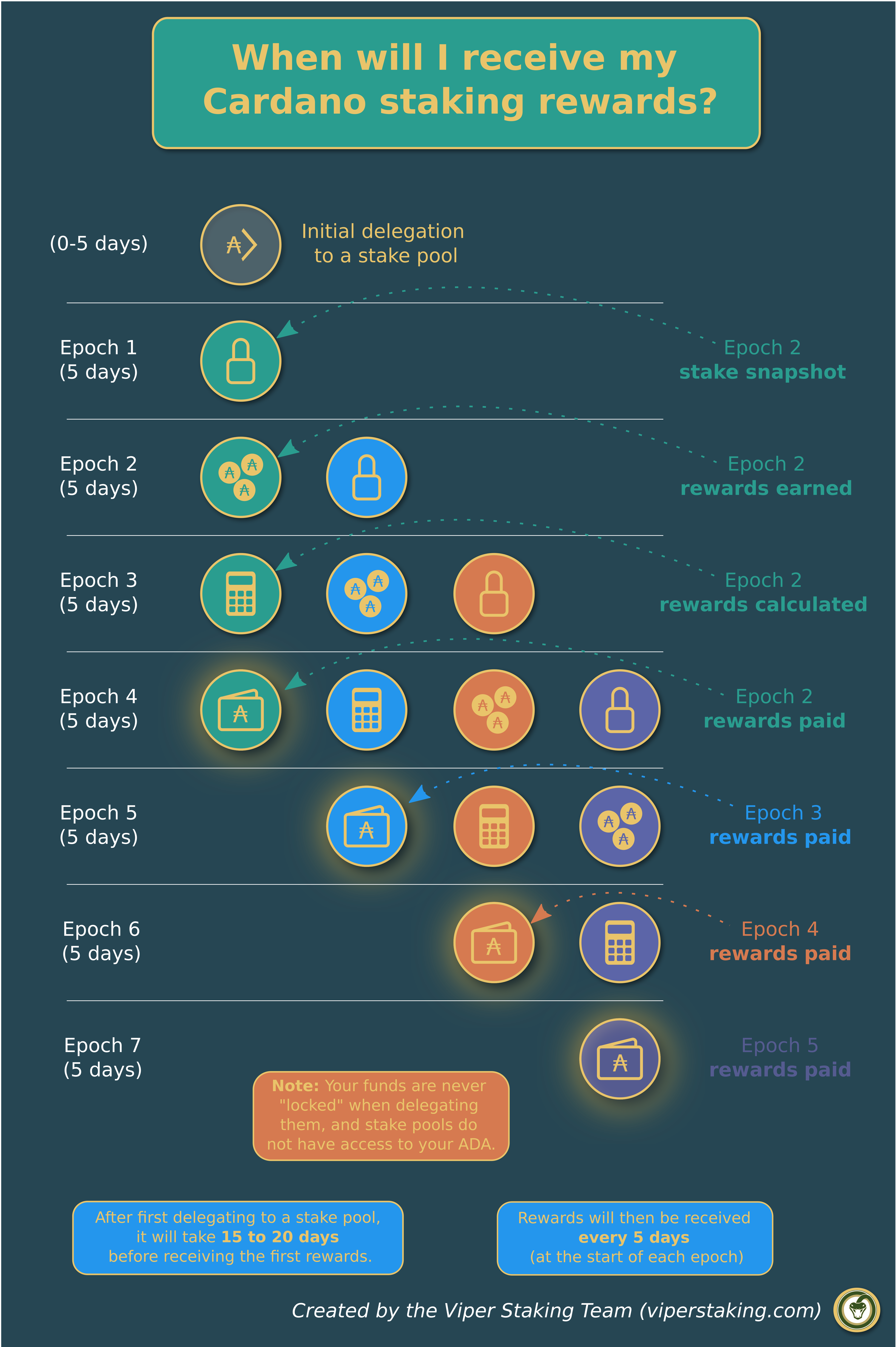The infographic below outlines the five steps of the stake delegation process:

——
1. Initial delegation to a stake pool
In order to stake your ADA, you’ll need to move your funds to a wallet that supports staking, such as Daedalus, Yoroi, or AdaLite. You’ll then need to decide on a stake pool to delegate your wallet to. With hundreds of active stake pools, choosing the best pool for you can be daunting. Our guide on Choosing a Stake Pool can help you through the process. When you delegate to a stake pool, you are delegating your entire wallet, not a specific amount of ADA. Whenever you add or remove funds from your wallet, your staked balance that is eligible to earn rewards will be updated.
A 2 ADA deposit is required to delegate your wallet. You can get this deposit back if you undelegate your wallet. There will also be a transaction fee for registering your wallet to stake (about 0.17 ADA), which you will not get back. This fee will also be assessed any time you choose to move your stake to another pool.
Your newly delegated stake will be included in your chosen stake pool at the beginning of the next epoch, as we explain next.
2. First stake snapshot
The accounting periods on the Cardano blockchain are called epochs. These occur every five days, and are the periods of time in which pools produce blocks and delegators earn rewards. The number of blocks a pool is eligible to produce is a random process governed by the amount of active stake in the stake pool. Active stake is the amount of ADA delegated to a stake pool during the stake snapshot that occurred at the beginning of the previous epoch.
Your funds are never “locked” when delegating to a pool and are solely under your control. You are free to spend your ADA whenever you’d like, and the stake pool does not have access to your funds. There is no risk of losing ADA when delegating your wallet.
3. Rewards are earned
Once your stake has been included in a stake snapshot, it will become active during the following epoch, which means it is eligible to earn rewards. You will earn a share of your stake pool’s rewards based on the amount of stake you have in the pool. The more blocks the pool produces during the epoch, the more rewards you will earn.
4. Rewards are calculated
After each epoch has concluded, the rewards for each of the stake pool’s delegators will be calculated based on the number of blocks produced by the pool.
5. Rewards are paid!
The rewards you earned during an epoch will be paid out at the beginning of the next epoch (1 full epoch after the rewards were earned). These rewards will be automatically included in your staked balance (and hence you will earn compounding returns on your delegation!), so you don’t need to manually claim your rewards every epoch in order to have them included. It will take 15 to 20 days between the time you first delegate your ADA and when you receive your first reward payout. After this, you will receive rewards every epoch (5 days) which were earned by your active stake from 2 epochs prior.
Common Scenarios
Below we will walk through concrete examples of common scenarios that can be confusing to delegators. These examples will use our Cardano Staking Calendar. Please refer to the excerpt below as we walk through each scenario:
| Epoch | Start Date | Stake Snapshot for Epoch | Rewards Paid for Epoch |
|---|---|---|---|
| 239 | Thu 31 Dec 2020 (21:45:00 UTC) | 240 | 237 |
| 240 | Tue 05 Jan 2021 (21:45:00 UTC) | 241 | 238 |
| 241 | Sun 10 Jan 2021 (21:45:00 UTC) | 242 | 239 |
| 242 | Fri 15 Jan 2021 (21:45:00 UTC) | 243 | 240 |
| 243 | Wed 20 Jan 2021 (21:45:00 UTC) | 244 | 241 |
Example 1: When will I receive my first rewards after staking my ADA?
If you first staked your ADA on January 1, 2021, your funds would be included in the Epoch 241 stake snapshot at the beginning of the next epoch, 240, on January 5th. You would earn rewards for the following epoch, 241. The rewards you earned in Epoch 241 would be calculated in Epoch 242. And finally, your Epoch 241 rewards would be paid in Epoch 243, on January 20th. From then on, rewards will be paid out every epoch for the rewards you earned 2 epochs prior (as shown in the “Rewards Paid for Epoch” column), e.g., on January 25th (Epoch 244) you will receive the rewards you earned in Epoch 242. In summary, it will take 15 to 20 days before you receive your first staking rewards (depending on when the next epoch starts).
Example 2: What happens if I add more ADA to my wallet that has already been delegated to a pool?
If you’ve previously staked your ADA and now you add funds to your wallet, your staked amount will be automatically increased. However, it must follow the same snapshot cycle as when you first staked your wallet. As in the previous example, if you added funds on January 1, 2021, the increased balance will be included in the Epoch 241 stake snapshot, which occurs at the beginning of Epoch 240. You will earn increased rewards in Epoch 241. The rewards you earned would be calculated in Epoch 242, and your first payout of increased rewards would be paid out in Epoch 243. In the meantime you would continue to receive rewards from your initial balance during epochs 240, 241, and 242 (as those rewards were earned in epochs prior to the increased stake).
Example 3: How do I move my staked ADA to a new wallet? Will I miss out on rewards?
If you’ve staked your ADA and decide to move your funds to a new wallet (e.g., perhaps you’ve wisely purchased a hardware wallet and would like to move your ADA to it), you will still need to be mindful of the 2 epoch delay in rewards payouts. Also, in order to claim rewards, you must have enough ADA in your wallet to cover the transaction fee (~0.17 ADA). Therefore, here is the process we would suggest (assuming you moved your funds on January 1, 2021):
Epoch 239
- [1 Jan 21] Move your ADA to the new wallet, but leave at least 1 ADA in the old wallet to cover a transaction fee.
- [1 Jan 21] Stake your new wallet. This balance will be included in the Epoch 241 stake snapshot. Note that you will have to pay a 2 ADA deposit to stake this new wallet, which you will get back when you undelegate the wallet.
- Your old wallet’s balance was “snapshot” at the beginning of Epoch 239. Therefore, it will earn rewards in the next epoch on this balance, even though you’ve moved the funds!
Epoch 240
- [5 Jan 21] The Epoch 241 stake snapshot occurs. The staked balance in your new wallet will now earn rewards in the next epoch (241).
- [5 Jan 21] Epoch 238 rewards are paid into your old wallet.
Epoch 241
- [10 Jan 21] The Epoch 242 stake snapshot occurs. Your new wallet begins earning rewards.
- [10 Jan 21] Epoch 239 rewards are paid into your old wallet.
Epoch 242
- [15 Jan 21] The Epoch 243 stake snapshot occurs and your new wallet continues to earn rewards.
- [15 Jan 21] Epoch 240 rewards are paid into your old wallet. This is the last epoch rewards were earned by the balance in your old wallet. You can now claim your rewards and undelegate your old wallet (which will also return your 2 ADA deposit). Send these funds to your new wallet.
Epoch 243
- [20 Jan 21] Your first rewards are paid into your new wallet (earned in Epoch 241). The stake snapshot for Epoch 244 occurs and picks up your entire balance (new wallet plus the earned rewards from your old wallet that you transferred on 15 Jan).
As you can see, you don’t miss out on any rewards by moving your funds to another wallet. While it takes 3 epochs to receive your first rewards in your new wallet, your old wallet continues to receive reward payouts for those 3 epochs.
Be sure to check out our staking tutorials for Daedalus and Yoroi wallets. If you have questions about staking or anything else related to Cardano, feel free to join our Telegram channel. Follow us on Twitter and Reddit to be notified of future posts!
The source of this information came from this IOHK whitepaper.


